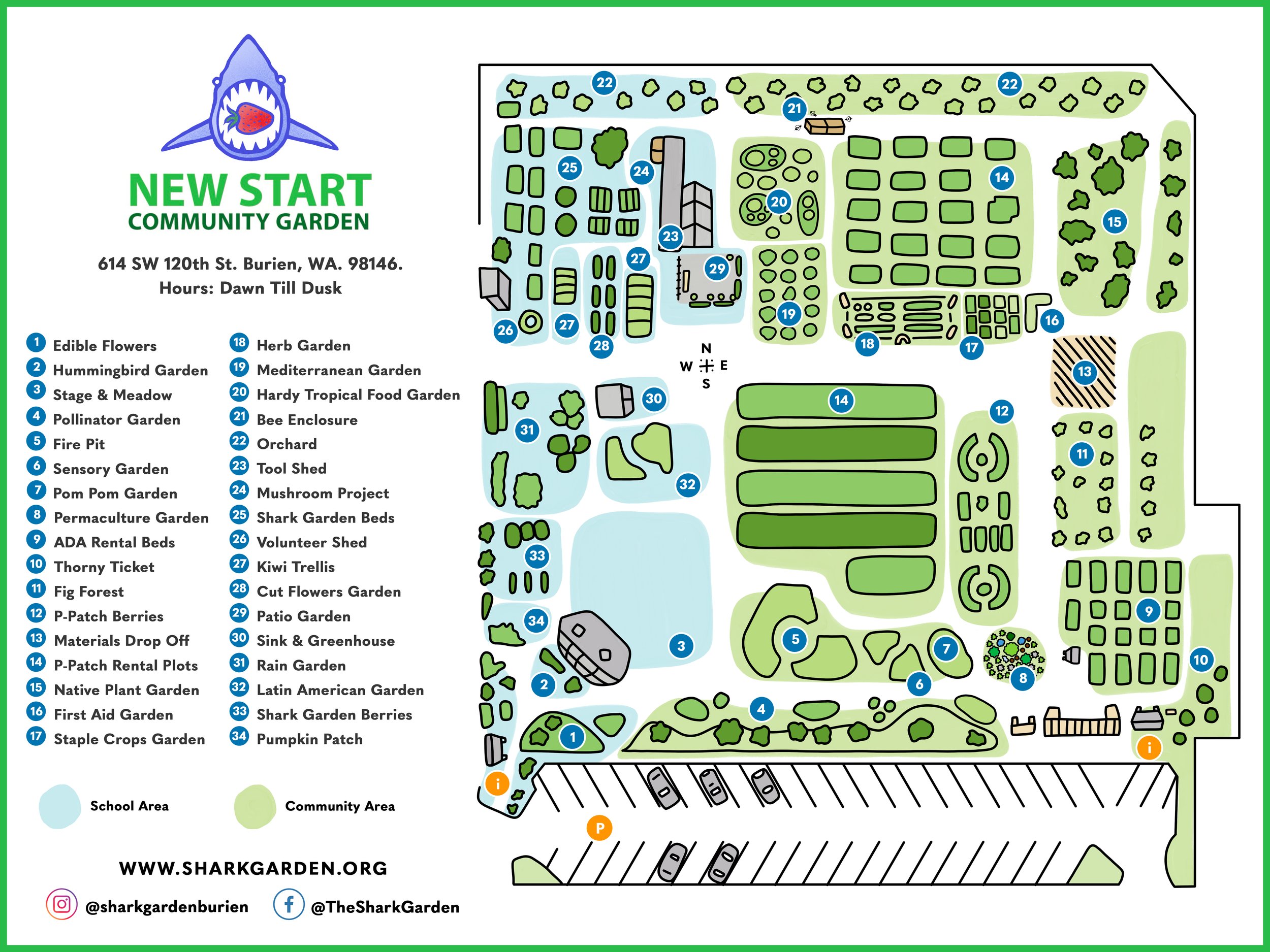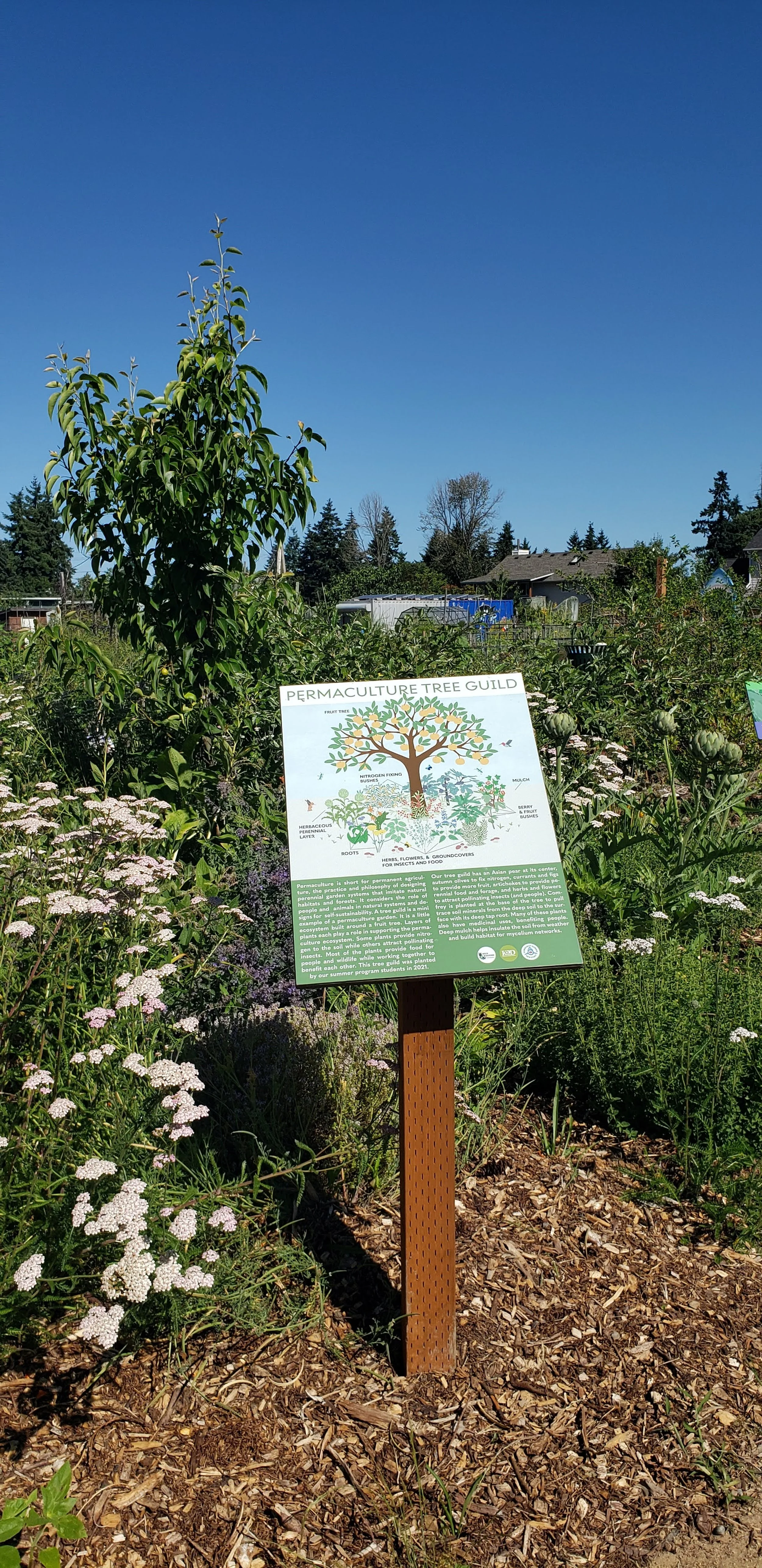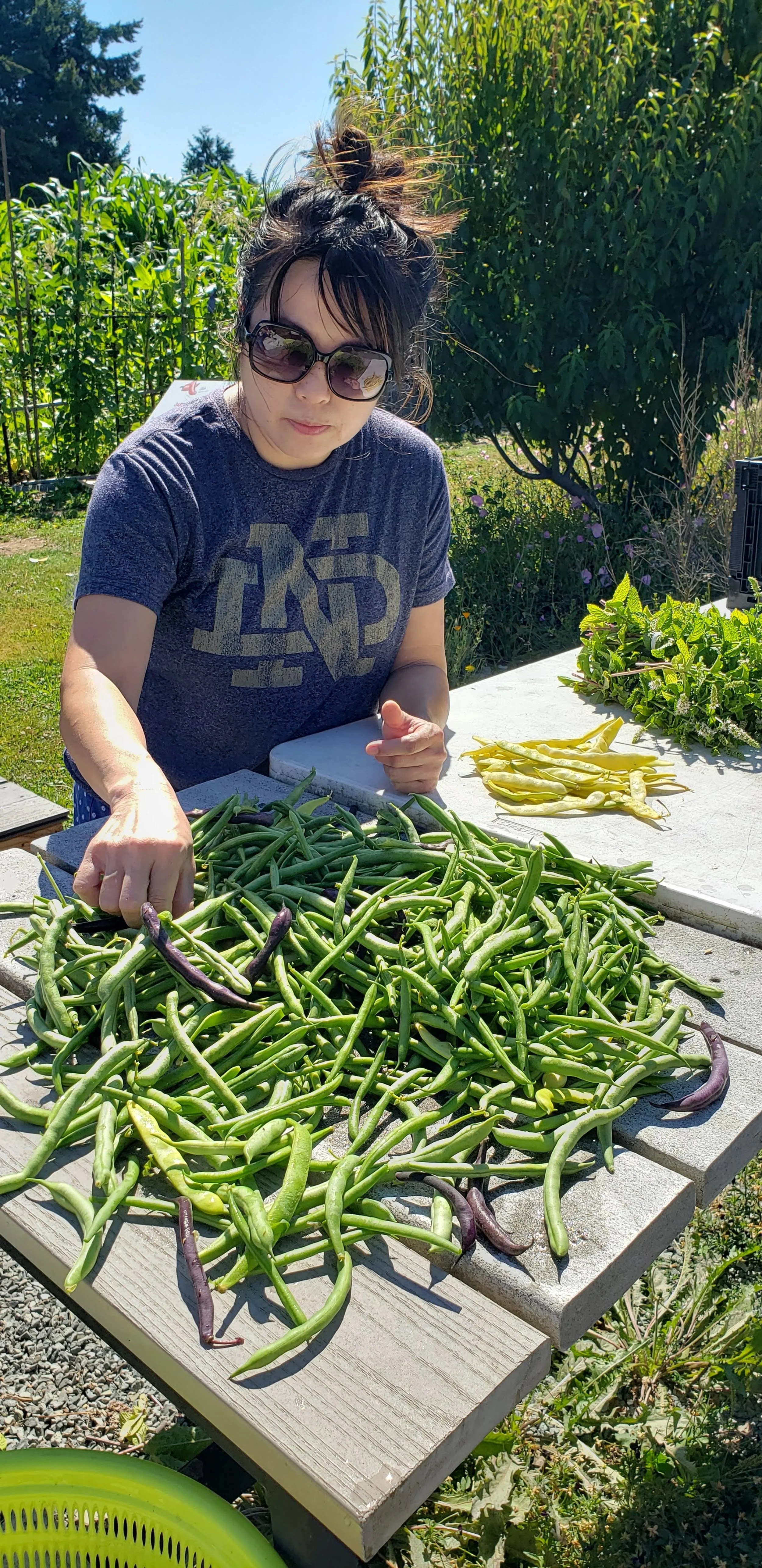
The New Start Community Garden is part botanical garden and we have a wide variety of specialty gardens to help teach visitors and students about the environment and growing food. Our botanical collections focus on edible plants and habitat for pollinators and wildlife.
Learn more about our Speciality Gardens below!

-
![image of the hummingbird garden with beautiful hot pokers, lobelias, penstemons, and salvias]()
Hummingbird Garden
Our Hummingbird Garden features some of the favorite flowers for our hummingbird friends from hot pokers and lobelias to penstemons and salvias. The old batting cage supports the Trumpet vines which are one of their favorites. We have two kinds of hummingbirds that visit the garden and our Anna’s Hummingbirds stay year round.
-
![Image of a variety of perennial flowers in brilliant red and orange hues]()
Edible Flowers Garden
Originally a student project, our Edible Flowers Garden features a variety of perennial flowers and a few self-seeding annuals that can be used in salads and desserts. Some of the flowers are harvested to make things for our fundraising sales.
-
![image of a butterfly on a large pinkish purple flower]()
Pollinator Garden
The large Pollinator Garden along our southern side is full of drought tolerant perennial flowers, herbs, berries, and fruit trees. The beds have some themes like the Goth Garden with all black and red flowers, the fluffy bed, the smelly bed, and more. Many of the beds are planted like permaculture tree guilds with a central fruit tree surrounded by berries, herbs, and flowers. This area also includes our “fire pit” for storytelling. Since the garden began, we have spotted more than 37 new pollinator species. This is a great area to bird watch too!
-
![Picture of the permaculture tree guild and information sign]()
Permaculture Tree Guild
Our little Permaculture Tree Guild bed was planted by students in 2021 as part of our summer program. It demonstrates permaculture principles with the creation of a mini food forest. The bed is centered around an Asian pear tree with supporting berries, herbs, perennial vegetables, edible flowers, fruit, and even mushrooms. The nitrogen fixing Autumn Olives feed the tree and our big comfrey plant in the middle brings nutrients up to the surface for all of the other plants.
-
![close up image of gooseberries]()
The Thorny Thicket
The Thorney Thicket houses some of the more thorny members of our berry collection like gooseberries, goji berries, and sea buckthorn. It also includes elderberries, honey berries, currants, goumis, and a fruiting Korean Dogwood tree.
-
![close up image of three hardy figs on a tree]()
Fig Forest
The Fig Forest contains over a dozen varieties of hardy figs that were donated by members of the Fig Addiction Facebook Group. We hope to eventually have a Fig Festival each fall so that everyone can taste the various varieties!
-
![image of various berries including raspberries, blueberries, blackberries, and strawberries]()
Berry Patch
The main Berry Patch is part of our p-patch garden. The plot renters share the harvest of the berries from this patch and help to take care of the plants. We have duplicate berries in our school garden that we share with the food bank and volunteers when they spend time with us. We do not allow public picking, but do have some guided picking events.
-
![close up image of berries]()
Native Plants (& Indigenous Foods)
Our native plant garden houses over 40 species of plants and we have focused our collection on those that have food value. We have lots of berries as well as edible flowers, leaves, roots, and fruits. Join us for one of our classes or guided picking events to get a taste of this collection. Public picking is not otherwise allowed. We also harvest berries from this area to make items for our fall bake sale fundraiser.
-
![close up image of grains in a paper bag]()
Grain Garden (& Staple Crops)
Installed in 2022, our Grain Garden features staple crops from around the world. Not many city dwellers know what some of these look like, so we thought we’d add a little demonstration garden to show folks in person. The grains are harvested in the fall during volunteer events and we then make things with them. We will also rotate in some other stable crops like soy beans and garbanzo beans from time to time.
-
![shark entrance to the herb and tea garden]()
Herb & Tea Garden
The Herb & Tea Garden was installed in 2021 with the generous support of the King Conservation District. It features over 25 perennial culinary herbs and plants for making herbal teas. We also add annual herbs like basil and stevia during the summers. These herbs are used for student projects during our summer program, for food bank harvests, and to make things for our fall bake sale fundraiser.
-
![Close up of a few green olives still growing]()
Mediterranean, Middle Eastern, & North African Foods Garden
This garden features food plants that originate around the Mediterranean from olives to artichokes, capers, to Italian herbs. Interesting fruit trees like quince, medlars, figs, mulberries, and Cornelian cherries add to the fun. Large rocks help hold the sun’s heat into these warm, dry and fast draining display gardens.
-
![Close up of a bee landing on a sunflower]()
Honey Bee Enclosure
Our Bee Enclosure is part of our Pollinator Program. On Thursday evenings from 5:30-7:30 volunteers come to learn beekeeping and take care of our Pollinator Garden and other projects to support our native pollinator insects. (April - mid Oct.)
-
![image of the onsite orchard sign]()
Orchard
Our orchard has over 30 varieties of fruits in it. Some trees have multiple varieties on one tree. These fruits are harvested for the White Center Food Bank and used during our classes and to make goodies for our fall bake sale fundraiser. Join us as a volunteer to get in on the taste tests and harvesting fun. We also have several classes each season about how to take care of fruit trees.
-
![Large chess board drawn on a patio with large chess pieces and a bench in the background]()
Patio Chess Garden
Our Patio Chess Garden was installed in 2023 in response to the demand for information about how to grow food in containers in small areas. It features a series of large containers and arbors surrounding a patio with a built in chess board. The garden is used to teach container gardening and drip irrigation classes and it provides a nice door step to our small greenhouse.
-
![Image of the 'Hardy Kiwi Trellis' sign that we have on site]()
Kiwi Arbors
We have two kiwi arbors up in the school food bank garden area. One arbor holds the fuzzy kiwis and the other one functions as a shade structure while holding up our hardy kiwis (A. arguta and A. polygama). Both of our arbors are made from recycled materials, a metal wheelchair ramp frame and old stop sign posts, so that they are strong enough to hold up the heavy vines and harvest.
-
![Woman picking at a pile of green beans laid on a table]()
School Food Bank Gardens
The western third of the garden is the original school garden, the Shark Garden. This area is used to teach students and community volunteers organic gardening while we grow thousands of pounds of organic produce for the White Center Food Bank each season. We work with the food bank each spring to determine which crops are culturally appropriate for their clientele. The harvest team of volunteers works during the week, usually on Wednesday mornings, from about April to late October. We do not allow public picking in the garden, but our volunteers are often sent home with produce.
-
![The Rain Garden sign on site with lots of green plants and trees growing all around it]()
Rain Garden
We have three rain gardens in total. The largest one is in the school garden and was an early student project. It collects surface water run off and filters it through native plants before it enters the drain that goes out to the Puget Sound. This is a great spot for bird watching too!
-
![Latin American Food Garden sign with vanilla, tomatoes, chili, corn, and pineapple graphics on it standing in front of the Latin American Food Garden plot]()
Latin American Food Garden
Our Latin American Foods Garden features over a dozen food plants from similar climates in Central and South America, from berries to fruit and root crops. These plants were donated by our friends at Wanderlust Nursery. Our research shows that there are many Latinx families in our area, so we wanted to feature some of these interesting food plants in our collection.
-
![Event taking place on top of the meadow with rows of canopy tents and vendors.]()
Meadow
Our meadow is where we have our community events in the summer from outdoor movies to art markets and our Burien Solar Punk Festival. We repurposed the old baseball batting cage to have a stage and the infield is now our open space for events. Our solar power system helps us power music, food, and more in this space.
-
![Entrance to the Tropical Garden]()
Hardy Tropical Foods Garden
In 2025, we installed a Hardy Tropical Foods Garden to showcase topical looking food plants from around the world that are hardy perennials here. We add some colorful annuals in for filler. This garden was inspired by the many families in our community from tropical parts of the world, to make them feel at home. Every plant in this garden is edible in some way from flowers to roots and fruits. A big thanks to Wanderlust Nursery for helping us source all these interesting foods!
-
![Blooming hardy prickly pear cacti]()
Hardy Cactus Garden (coming 2026)
In 2026, we are installing a new display garden for hardy edible cacti and desert plants. The collection will be mostly hardy prickly pear species with edible fruit and pads, but we will also have some more unusual desert food plants included. This garden is inspired by our interest in both saving water with drought tolerant plants and the diversity of edible plants found in desert habitats and gardens.
-
![Mushroom Growing Info Sign]()
Mushrooms Garden
In 2024, we started a project to grow edible mushrooms and teach folks how to do so at home. While we’ve had a Wine Caps Mushroom project going since 2016 in our wood chip paths, this expanded mushroom garden includes seven more varieties so far. We collected donated used mushroom blocks from a local commercial grower and stack them into walls where we can get a few more harvests out of them to support our volunteers, as a perk, and our fundraiser sales items. We also offer two free classes each season on how to grow and forage for mushrooms with our partner Stone Soup Gardens. We currently have three areas with mushroom walls and the used blocks go to compost our orchard.
-
![Sign for Edible Bog Garden]()
Edible Bog Garden
In 2025, we started installing a small bog garden on the western side of out big tool shed. It features water loving food plants from around the world that are hardy here or grown as annuals in more tropical areas with rice paddy fields. This garden was inspired by some of our gardeners from Vietnam who asked if we could grow some of the paddy crops like water spinach (annual here). We’ve also added hardy crops like our native wapato, water cress, and water chestnuts. More species will be added in 2026 into a second bed.
-
![Berries from the Arctic region]()
Arctic Foods Garden
We are currently seeking funding for a new display garden to go in next year (2027) to showcase food plants from the Arctic regions of the world. This garden will include lots of low growing berries and a few other interesting edible plants used by indigenous peoples of the Arctic. We estimate that the garden will cost about $5-8K depending on the hardscape involved. If you’d like to support this project, contact us at info@sharkgarden.org.
























